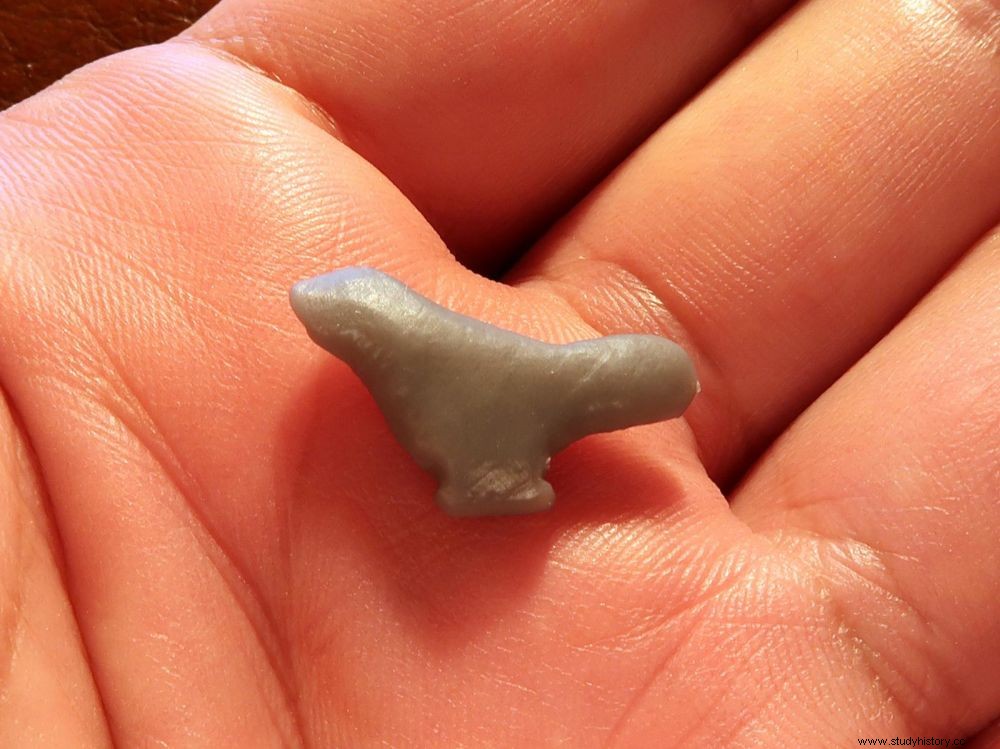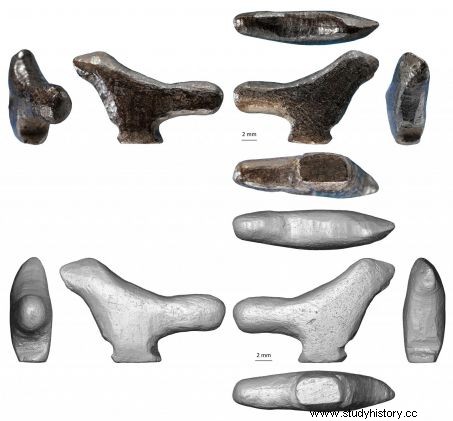Just a few millimeters tall, this bird figurine found on the Chinese site of Lingjing pushes back the appearance of figurative sculpture in East Asia by more than eight millennia. It could also help to better understand why the latter appeared much earlier in Europe, between 35,000 and 40,000 years ago.

This tiny bird found at the outdoor site in Lingjing, China, measures barely 2 cm. However, it is the oldest work of art ever inventoried in the country. Here, a 3D cast made from the original, visible below in the article.
This tiny, ossicle-like bird almost ended up buried in a bag of rubble good for the landfill. Because it was during the digging of a well, and not during archaeological excavations, that the small statuette was found. Zhanyang Li, archaeologist and paleontologist at the University of Shandong, in eastern China, fortunately had the good sense to sieve this earth directly taken from a prehistoric site which had already yielded many treasures:that of Lingjing , in the Chinese province of Henan. In 2007 and 2008, the fragments of two adult human skulls dated from 105,000 to 125,000 years ago were notably recovered there in lake sediments.
A simple piece of bone? No, miniature art
The small statuette probably representing a sparrow is "only" about 13,000 years old. It is, however, the oldest figurative sculpture ever discovered to date in all of East Asia, an area that stretches from China to Australia. This Wednesday, June 10, 2020, an article in the magazine PLOS ONE is dedicated to him. To find an ancestor for this small sculpted work on the Asian continent, you have to go to the Palaeolithic site of Malta, west of Siberia, where several figurative sculptures dating back 16,000 years have been unearthed. "Malta remaining at over 2000 kilometres from Liungjing, it is still difficult to connect these discoveries" , warns Francesco d'Errico, archaeologist at the laboratory "From prehistory to the present:culture, environment and anthropology" (CNRS / University of Bordeaux), and main author of the study.

More than the age of the statue, it is above all the important work provided for its design that kept the researcher in suspense in his Bordeaux laboratory. "The bird has no less than 68 micro-facets indicating that it is indeed an anthropogenic creation and not an accident of nature:marks of abrasion, chipping, scraping, incision..." , lists Francesco d’Errico. “The bone was also probably intentionally burned to achieve this brown hue. a precise result with techniques that he or she mastered." Its tail, in this case, is deliberately disproportionate to the rest of its body so that it does not collapse forward once placed on its small pedestal. "The sculptor knew very well what he was doing. And for such a small object, it's a lot of effort."
Because our little bird carved from burnt bone is no bigger… than a dry bean. A very restrictive particularity for achieving carbon 14 dating:this effective but invasive technique requires taking the equivalent of a 1x1 centimeter sample from the work. That's half the bird! "It was impossible. We had to rely on the carbon-14 analysis of other pieces of charred bones found in the sediment" , says Francesco d'Errico, who also subjected the object to advanced analysis techniques such as confocal microscopy or microtomography.
This tiny, ossicle-like bird almost ended up buried in a bag of rubble good for the landfill. Because it was during the digging of a well, and not during archaeological excavations, that the small statuette was found. Zhanyang Li, archaeologist and paleontologist at the University of Shandong, in eastern China, fortunately had the good sense to sieve this earth directly taken from a prehistoric site which had already yielded many treasures:that of Lingjing , in the Chinese province of Henan. In 2007 and 2008, the fragments of two adult human skulls dated from 105,000 to 125,000 years ago were notably recovered there in lake sediments.
A simple piece of bone? No, miniature art
The small statuette probably representing a sparrow is "only" about 13,000 years old. It is, however, the oldest figurative sculpture ever discovered to date in all of East Asia, an area that stretches from China to Australia. This Wednesday, June 10, 2020, an article in the magazine PLOS ONE is dedicated to him. To find an ancestor for this small sculpted work on the Asian continent, you have to go to the Palaeolithic site of Malta, west of Siberia, where several figurative sculptures dating back 16,000 years have been unearthed. "Malta remaining at over 2000 kilometres from Liungjing, it is still difficult to connect these discoveries" , warns Francesco d'Errico, archaeologist at the laboratory "From prehistory to the present:culture, environment and anthropology" (CNRS / University of Bordeaux), and main author of the study.

More than the age of the statue, it is above all the important work provided for its design that kept the researcher in suspense in his Bordeaux laboratory. "The bird has no less than 68 micro-facets indicating that it is indeed an anthropogenic creation and not an accident of nature:marks of abrasion, chipping, scraping, incision..." , lists Francesco d’Errico. “The bone was also probably intentionally burned to achieve this brown hue. a precise result with techniques that he or she mastered." Its tail, in this case, is deliberately disproportionate to the rest of its body so that it does not collapse forward once placed on its small pedestal. "The sculptor knew very well what he was doing. And for such a small object, it's a lot of effort."
Because our little bird carved from burnt bone is no bigger… than a dry bean. A very restrictive particularity for achieving carbon 14 dating:this effective but invasive technique requires taking the equivalent of a 1x1 centimeter sample from the work. That's half the bird! "It was impossible. We had to rely on the carbon-14 analysis of other pieces of charred bones found in the sediment" , says Francesco d'Errico, who also subjected the object to advanced analysis techniques such as confocal microscopy or microtomography.
A missing link
Tiny as it may be, this bird is nonetheless a big boost in our knowledge of Paleolithic artistic traditions:it pushes back the origin of sculpture and animal representations in East Asia by 8,500 years. 'Est (excluding Malta from this area), even if it does not manage to fill the gaping chronological gap which separates it from the oldest known statuettes in the history of humanity. Among them, the Venus of Hohle-Fels or even a strange man with the head of a lion, figures both unearthed in 2008 on the site of Hohle-Fels, in eastern Germany. The Venus, made of mammoth ivory, could date back up to 40,000 years. Known as the Aurignacian, this period corresponds to the arrival of the first modern humans in Europe.
But then how to explain that nearly 27,000 years separate the appearance of three-dimensional art in these two parts of the world, even though hearths of more than 500,000 to 600,000 years have been identified on Chinese territory? "It's still a real mystery" , answers Patrick Paillet, prehistorian for the Natural History Museum who did not participate in the study. "As always, we reason according to the current state of our knowledge. We are not immune to discovering even older things, whether in Asia or Europe." For Patrick Paillet, the little Chinese bird nevertheless remains an element"too isolated" so that we can draw conclusions about the origins of Asian sculpture.
Francesco D'Errico also admits that research itself may play a part in not having older sculptures in this part of the world. "If they are all the size of this object, it is quite possible that they have been missed often during previous excavations." Especially since the scale of this figurine is not exceptional, at least there again in Europe:in the Bourouilla cave, located in the Pyrénées-Atlantiques, were found several animals not exceeding 1.5 centimeters in height. long or tall, sometimes sculpted with great detail. Dated from the Magdalenian, around 14,000 to 15,000 years ago, they tend to prove that portable art from the Upper Palaeolithic tended to become miniaturized.
Birds, an underrepresented animal
One detail nevertheless caught the attention of Patrick Paillet:"We know that certain birds were hunted for their meat, their feathers or their claws, used for ornaments. But their representation is rare throughout the Upper Paleolithic. There are a hundred at most, parietal art included." Why a bird? And what could such a small object be used for? Francesco d'Errico can only speculate here:"I personally think that it was an object intended to be carried, probably in a bag... It was not in my opinion isolated and lived in relation to other small objects. Perhaps the whole thing had a shamanic dimension", suggests the archaeologist. To hope to have confirmation of this one day, we will have to continue to sift... and keep our eyes wide open.
